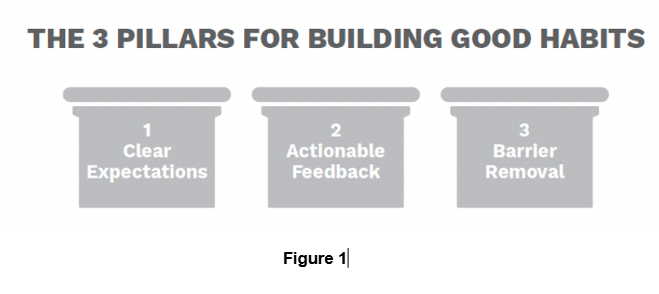Struggling to Get Consistent Vital Behaviors in Your Organization?
Leaders can make employees more productive by identifying and nurturing Vital Behaviors. Julie Smith and Lori Ludwig outline a five-step process.
“Why do our in-home technicians do things that upset our cable customers? I hit the roof when we had to shell out $5K to fix the mess left by one tech. Dragging muddy shoes over a white carpet—seriously? How hard is it to show some basic respect?”
—Senior Leader “CoreLink Communications”
Let’s face it — getting key behaviors to stick in your organization can feel like herding cats. This is especially true when you need hundreds or even thousands of employees to deliver products or services in a consistent, high-quality way.
Behavior variability is a silent killer of business results
The ripple effect of unwanted behavior variability can be far-reaching. At the cable company, poor customer service by technicians led to numerous callbacks to the customer care center, driving up costs for call center personnel. Worse yet, poor service drove customers to competitors.
Vital Behaviors are the cure for creating consistency!
Luckily, there is an effective way to instill consistent habits in employees. The key is to focus on Vital Behaviors. These are the critical few actions that drive the most significant impact on results.
The 80/20 rule applies: 20% of behaviors will lead to 80% of the desired results. For instance, if cable technicians focus on a few Vital Behaviors, it will dramatically improve customer satisfaction and reduce call-backs. But what are the Vital Behaviors for cable technicians, and how do you get them going?
There’s a proven, simple way to embed Vital Behaviors as habits
There is a streamlined 5-step process for identifying Vital Behaviors and nurturing them until they become deeply embedded cultural habits. Here’s how the cable company used the five steps to improve its results.
Step 1: Identify the results you want to improve by reducing behavior variability. The company’s leaders knew they needed to improve customer satisfaction scores for in-home services and reduce costs associated with unnecessary customer callbacks in the call centers. They set goals for both areas.
Step 2: Identify the Key Performer Group that most impact those results. At the cable company, everyone had a role in ensuring customer satisfaction, but the technicians had an outsized role. After all, they spent the most time with customers during those “moments of truth” when customers needed their issues resolved on the first call.
With 8,000 technicians completing five service calls a day, they had 40,000 opportunities every day to fix technical issues and provide exemplary customer service. They had the power to turn the company’s customers into loyal fans!
Step 3: Pinpoint the Vital Behaviors that Key Performers need to do consistently. An analysis of call-back data revealed the top four Vital Behaviors technicians needed to perform every visit to ensure perfect service was provided.
Four Vital Behaviors for in-home technicians
- Let the customer know when you will arrive.
- Explain what you have installed or fixed.
- Help the customer learn to use the equipment.
- Clean up any messes you make in the customer’s home.
Customer focus groups confirmed these four behaviors would significantly boost satisfaction.
Step 4: Develop feedback loops to help Key Performers know how they’re doing. Since technicians worked remotely with no direct supervision, customers were the only ones who could provide meaningful feedback. After a home visit, a quick pulse check was sent to customers to ask whether they had seen their technician do the four behaviors.
Supervisors also called a sample of customers to get more specific behavioral data. This individualized feedback was sent to technicians daily so they could see immediately how they were doing on the Vital Behaviors.
Step 5: Ensure leaders support employees in turning Vital Behaviors into durable habits. There are three Pillars on which all employees need to build good habits at work (Figure 1).

Surprisingly, Gallup’s research shows that only 30% of employees report getting these three pillars from their leaders, leading to a lot of variability in unproductive behavior. When Gallup correlated its survey results with actual organizational performance, it found that when 80% of workers received this essential performance support, numerous performance indicators dramatically improved (Figure 2). These results also match decades of client data, as well as 50 years of research in the field of Organizational Behavior Management (OBM).

At the cable company, supervisors ensured that each employee received these three Pillars during 1:1 weekly check-ins and daily team huddles. Pulse check data were reviewed to determine which of the three Pillars needed strengthening to ensure that the Vital Behaviors became enduring habits.
Results summary
When technicians reliably performed the four behaviors and their leaders taught everyone the three Pillars, the company’s customer satisfaction scores soared, and call-backs decreased drastically. Because call center staff were dealing with fewer complaints, staffing levels decreased to meet industry standards, dramatically reducing costs. All of this was achieved in four months through a low-cost solution based on targeted behavior change.
The power of Vital Behaviors
When Vital Behaviors become a focal point, it lets everyone know which actions are top priorities. Leaders and associates can work together to monitor whether people are doing them and which of the three Pillars needs strengthening.
A focus on Vital Behaviors has delivered tremendous success for many large and small organizations worldwide, helping them improve multiple targeted results such as quality, safety, productivity, customer satisfaction and costs. The time is now for your organization to unleash the power of Vital Behaviors, too!
“We learned that behavior inconsistency is costly, but consistency is priceless! I only wish I’d discovered this simpler, cost-effective way to build reliable habits at scale sooner!”
—Same Senior Leader
Written by: Dr. Julie Smith, a trailblazer in large-scale organizational behavior change, and Dr. Lori Ludwig, renowned for her extraordinary skill in guiding organizations to align strategy with processes, roles and behaviors, resulting in high-impact, meaningful results, for SmartBrief.
